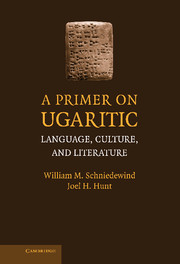6 - Literary Texts (KTU 1)
Published online by Cambridge University Press: 05 June 2012
Summary
Most of the major literary texts from Ugaritic are in the form of narrative poems. Included here are selections from the three most famous poems: the Baal Cycle (§§6.2 and 6.5), the Keret Epic (§6.3), and the Story of Aqhat (§6.6). In addition, we have provided a selection from El's Marziḥu (§6.1), which can be read with the legal text dealing with the Marziḥu in Chapter 5 (§5.3). The so-called Snake Bite Text (§6.4) has been the subject of numerous studies and has been one of the more difficult texts to understand; it seems to have been used in a ritual. The Birth of the Goodly Gods (§6.7) describes the sexual activity of the god El with much metaphorical language and the birth of two gods with ravenous appetites.
Near Eastern literary texts, including Ugaritic texts, rely heavily on parallelism and standard formulas. Parallelism involves the juxtaposition of phrases using similar syntactic and semantic structures. Standard formulas include the marking of time, the introduction of direct speech, the entrance and exit of characters, and the use of divine epithets. Although these can seem redundant, they reflect the oral recitation of these literary texts (see S. Parker, Stories in Scripture and Inscriptions). A main problem that the student will face in studying these literary texts is their fragmentary nature. Even where they are complete, there are many obscurites in the vocabulary or in understanding the ancient Ugaritic social context.
- Type
- Chapter
- Information
- A Primer on UgariticLanguage, Culture and Literature, pp. 117 - 148Publisher: Cambridge University PressPrint publication year: 2007

